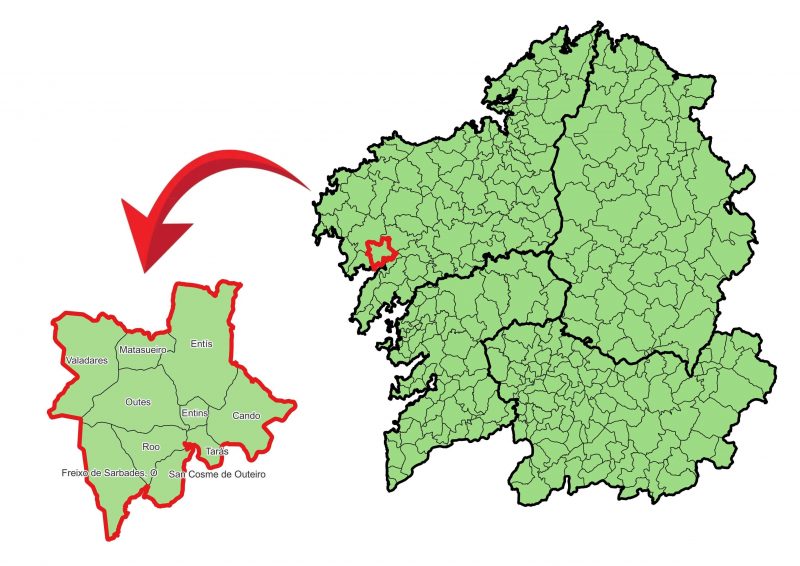
Introduction
The municipality of Outes is located in the Noia region, to the southwest of the province of A Coruña and 40 kilometres from Santiago de Compostela. It is a coastal area with a population of 6,000 and a surface area of 99.74 square kilometres, which, according to the Galician Institute of Statistics, shows a degree of urbanisation in a sparsely populated area.
It is part of the DELOA Rural Development Group (RDG18).

Population and demographic structure
The population of Outes registered a continuous decrease of inhabitants from 2012 to 2022 with a decrease of -15%. Over the same period, Outes experienced a progressive ageing of its population. The age group suffering the greatest population loss was the under-64s, with a particular impact on children under the age of 15, which represents a reduction of 40%.
The increase in the Total Dependency Ratio (TDR) in Outes was significant and much higher than in A Coruña and Galicia as a whole. It reached 82% in 2022. The demographic pyramid was shrinking at the base and the average age was increasing, reaching 53 years.
It confirms the demographic decline and ageing that affects the social, economic, and cultural levels.

Population dynamics in Outes.

Evolution of the total dependency ratio of Outes, A Coruña and Galicia.
Economy
The evolution of Gross Disposable Product (GDP) followed the same growth trend as the province of A Coruña and Galicia. After an initial decline between 2010 and 2012, growth rates were positive until 2020. Then, as a result of the pandemic, it fell by 11.5%, with a greater impact than in A Coruña (-10.5%) or Galicia (-7.7%). Outes has a GDP of almost 12,000 euros in 2020.
The Gross Disposable Income (GDI) showed the same positive evolution as in Galicia and the province, with a significant increase of 40% between 2002 and 2019. As a result of the pandemic, GADR per inhabitant fell by 6% to 14,180 euros.
Using the register of social security affiliations as an estimate of municipal employment, Outes had a 2% increase in employment between 2011 and 2022. In terms of sectors, the primary sector lost a considerable weight with a decrease of 20% since 2011; the industrial sector showed a slight increase of 1.7%, while the services sector increased by 25%.
In 2022, Outes had a very high activity rate of 71%. The employment rate will be 65% in 2022. The unemployment rate is 10%, affecting a total of 243 people.

Evolution of Gross Disposable Income per inhabitant in Outes, A Coruña and Galicia.

Evolution of employment, unemployment, and activity rates in the municipality of Outes.
Energy resources
Pedregal Tremuzo wind farm was commissioned in 2003 and is currently operational. It has 30 wind turbines with an installed capacity of 25.5 MW. Its estimated average production over the last 10 years has been 67,472.24 MWh. In addition, Banzas and Outes wind farms have the administrative authorisation for construction after having obtained a favourable environmental impact statement. The installed capacity of the former will be 31.185 MW, with 9 wind turbines, and 21 MW in the latter, with 6 wind turbines.
The electricity consumption of Outes has been 12,098.09 MWh in 2023. The residential consumption was 8,507.59 MWh. The consumption of services, including municipal services, was 3,307.64 MWh. Industry consumed 282.87 MWh.
Energy Policy Councils
Date of the first meeting:
19th February 2024
Number of participants:
24 people
Profile of participants:
- Outes staff: Mayor’s office, town hall secretary, local employment technician
- EC4RURAL project assistants: UVIGO, ESPAZOCOOP, FEGAMP
- Citizenship
Evaluation of the energy situation
The Mayor of Outes stated that not being dependent on the electricity supply of large external companies, making savings on the town’s budget and being a local authority committed to renewable energy were the main reasons for the town’s participation in the EC4RURAL project.
Outes has developed a project to install photovoltaic energy in the municipal swimming pool. There will be a surplus that could be shared with the future local energy community.
Dialogue between the parties
During the meeting there was an open dialogue between citizens and Outes staff on photovoltaic energy production. Aspects related to business models were discussed. Emphasis should be put on the open participation of citizens and small and medium enterprises.
Conclusions
After the joint co-creative process, the first contact with the neighbourhood and local authorities have been positive. There is a real interest in the development of the rural energy community as they think about joint action and the benefits of making it happen.
As a final conclusion of this meeting, the Energy Policy Council has been created.



